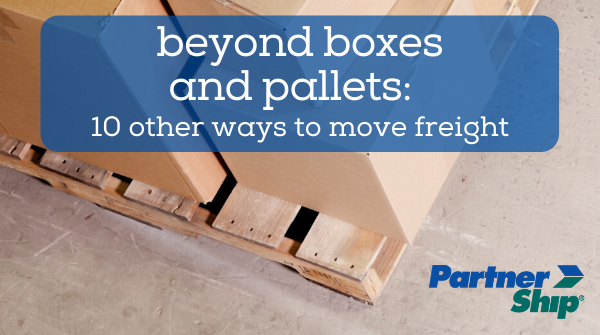Beyond Boxes and Pallets: 10 Other Ways to Move Freight
01/03/2020 — PartnerShip

When most people think of freight, it’s usually an image of the ubiquitous 40” x 48” wood pallet that comes to mind. But there are many other ways to move freight, including these lesser known, but still important, methods.
Pallets. They are so important to freight shipping that even though we’ve covered pallets in depth before, we can’t not mention them here.
In addition to wood, pallets can be made of plastic or metal. Plastic pallets are popular for export shipments because they don’t have to be heat treated to be used for international shipping, like wood pallets do. Aluminum and stainless steel pallets are strong and lightweight, and since they can be cleaned and sanitized, they can be used in food processing and pharmaceutical plants, where cleanliness is essential.
Gaylords. Named after the company that first introduced them, Gaylords are pallet-sized corrugated boxes used for storage and shipping. Sometimes called pallet boxes, bulk boxes, skid boxes and pallet containers, Gaylords can have between 2 and 5 walls and are meant to be single-use containers. Frequently used as in-store displays as well as shipping containers, Gaylords can be used to ship items as diverse as watermelons, stuffed animals, and pillows. Depending on configuration and how many walls they have, Gaylords can hold from 500 to 5000 pounds each.
Metal bins. Metal bins are typically made of steel and are mainly used in industrial applications where strong-sided containers are required to hold and move heavy and irregularly shaped items, like metal castings and forgings, stampings and scrap metal. Metal bins can be found in many different sizes and are essential in safely shipping heavy and potentially sharp objects.
Wire baskets. Available in solid or collapsible versions, wire baskets are strong and can store and move large and bulky items up to 6000 pounds. Wire baskets are stackable and can be used for shipping nursery stock, landscaping rocks, and other irregularly shaped items.Stack racks. Featuring a flat, metal base and upright posts at the corners, stack racks are ideal for moving and storing large, bulky items. Stack racks can often be stacked on top of one another and are used for moving awkward items like furniture, carpets and rolls of fabric, tires, and coiled plastic drainage tubing.
Bulk storage bags. Perfect for moving powders, grains and very small items, these durable woven plastic bags have lift straps attached to the top which allow them to be filled, moved and emptied easily. Bulk storage bags are sometimes called big bags, super sacks, or FIBCs (Flexible Intermediate Bulk Containers), and can be lined for food-grade applications like shipping flour and peanuts, industrial products like dry concrete mix, or bulk agricultural freight like catnip.Wood crates. Shipping crates made of wood are sturdy, strong, and can typically resist the sometimes extreme conditions of freight shipping. Items shipped using wood crates can be as diverse as priceless artwork, sensitive machines like 3D printers, and large and irregularly-shaped plastic injection or blow molds. Other common uses of wood crates are tradeshow exhibit shipments and when moving multiple slabs of natural stone.
IBC Totes. Intermediate Bulk Containers, or IBC totes, are perfect for transporting liquids and granular materials, like chemicals, food products and hazardous materials. IBCs can hold up to 550 gallons, with 275 and 300 gallons being the most common sizes. IBCs are stackable and can be used for food grade materials as well as corrosive or flammable industrial liquids and solvents.Totes. Totes are small plastic containers that are commonly used in manufacturing and food processing facilities, as well as in shipping, storage and fulfillment warehouses. Totes without lids are often used for order picking in warehouses, and are useful because they are durable, nestable and stackable. Totes with lids that close are frequently used in shipping small products from distribution centers to stores, and are included in shrink-wrapped pallets of boxes.
Drums. Storage drums come in three main types: fiber, plastic and metal, and can be used to store and ship liquids and solids. Fiber drums are lightweight and sturdy and can hold food-grade and non food-grade materials such as grains and dry chemicals. Plastic drums can hold liquids or solids and are corrosion resistant, making them ideal containers for transporting industrial chemicals; they can also be food-grade and hold water, pickles or grape juice for winemaking. Metal drums are used for heavier liquids such as oils, greases and lubricants, and extremely hazardous materials, since they are the most durable drums available.
Plastic and metal drums are available in both open-head and closed-head designs. Open-head drums have easily-removable covers and work well for shipping solid items or thicker liquids. Closed-head drums have non-removable covers with openings and are better suited for lower-viscosity liquids.
The most common size of fiber and metal drums is 55 gallons, while plastic drums are available in standard sizes of 15, 30 and 55 gallons.A-Frames. Shipping granite, quartz and marble requires the use of wood or metal A-frames to hold and stabilize natural stone slabs when they are shipped. A-frames are mostly used on local or short hauls, and can be loaded in dry vans, or more commonly, on flatbeds for transport. There are many factors to consider when shipping stone and working with an expert is certainly recommended.
As you can see, there are many more ways besides boxes and pallets to move your freight, and no matter how your freight is configured, we’re here to help you ship smarter. If you have a shipping challenge and need assistance finding a reliable carrier for your needs, contact PartnerShip or get a free quote!
